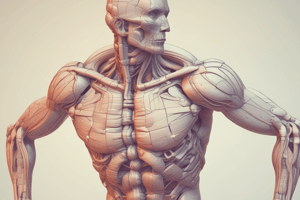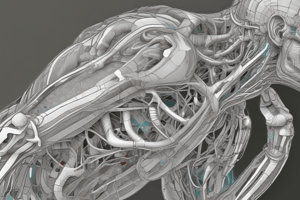Podcast
Questions and Answers
What is the correct starting position for shoulder ROM testing when limited in flexion and abduction?
What is the correct starting position for shoulder ROM testing when limited in flexion and abduction?
- Arm positioned above the shoulder flexed at 90 degrees
- Arm fully extended upwards while lying prone
- Arm hanging freely by the side of the table
- Arm supported at its maximal range of elevation over the table (correct)
Which muscle is the primary muscle responsible for scapular adduction and downward rotation?
Which muscle is the primary muscle responsible for scapular adduction and downward rotation?
- Levator Scapulae
- Pectoralis Minor
- Middle Trapezius
- Rhomboids Major (correct)
During the alternative rhomboid test, what anatomical position should the patient's head be in?
During the alternative rhomboid test, what anatomical position should the patient's head be in?
- Tilted back to enhance scapular stability
- Turned to the opposite side to exclude levator scapula (correct)
- Turned to the same side to engage the levator scapula
- Facing forward to allow full range of motion
What should the examiner do if the shoulder extensors are graded at 3 or more during the adduction and downward rotation test?
What should the examiner do if the shoulder extensors are graded at 3 or more during the adduction and downward rotation test?
Which substitution may occur during a rhomboid test due to trunk rotation?
Which substitution may occur during a rhomboid test due to trunk rotation?
What is the primary muscle tested during scapular abduction and upward rotation?
What is the primary muscle tested during scapular abduction and upward rotation?
What is the starting position for testing muscle grade when the resistance is applied?
What is the starting position for testing muscle grade when the resistance is applied?
In the context of muscle testing, what does 'palpation' refer to?
In the context of muscle testing, what does 'palpation' refer to?
Which muscle group acts as an accessory during scapular abduction and upward rotation?
Which muscle group acts as an accessory during scapular abduction and upward rotation?
What grade indication suggests that the muscle can perform movement against gravity without resistance?
What grade indication suggests that the muscle can perform movement against gravity without resistance?
Which scapular movement is characterized by bringing the scapula away from the spine?
Which scapular movement is characterized by bringing the scapula away from the spine?
What is significant about a muscle performing a grade of 1 during testing?
What is significant about a muscle performing a grade of 1 during testing?
During a manual muscle test, what instruction is given for the arm position at the start of the test?
During a manual muscle test, what instruction is given for the arm position at the start of the test?
What is the primary goal when stabilizing the contralateral scapular area during scapular adduction?
What is the primary goal when stabilizing the contralateral scapular area during scapular adduction?
What action should be taken when the posterior deltoid muscle is weak during scapular adduction testing?
What action should be taken when the posterior deltoid muscle is weak during scapular adduction testing?
In which position should the patient be when evaluating scapular depression and adduction?
In which position should the patient be when evaluating scapular depression and adduction?
What is the significance of grade 3 in the context of scapular adduction testing?
What is the significance of grade 3 in the context of scapular adduction testing?
What is the primary muscle responsible for scapular adduction, aside from the middle trapezius?
What is the primary muscle responsible for scapular adduction, aside from the middle trapezius?
During the scapular adduction assessment, resistance is given in which direction?
During the scapular adduction assessment, resistance is given in which direction?
Which primary muscle is primarily involved in the movement of scapular depression and adduction?
Which primary muscle is primarily involved in the movement of scapular depression and adduction?
What should a therapist do to prevent trunk rotation during scapular adduction testing?
What should a therapist do to prevent trunk rotation during scapular adduction testing?
What is the proper test position for assessing Grade 3 scapula movement in relation to the arm?
What is the proper test position for assessing Grade 3 scapula movement in relation to the arm?
In what situation would a clinician test for scapular elevation?
In what situation would a clinician test for scapular elevation?
What muscles are primarily responsible for scapular elevation?
What muscles are primarily responsible for scapular elevation?
Which grade of muscle function indicates that the scapula can move through full range of motion without winging?
Which grade of muscle function indicates that the scapula can move through full range of motion without winging?
What is the primary purpose of palpating the serratus muscle during the assessment?
What is the primary purpose of palpating the serratus muscle during the assessment?
During scapular retraction testing at grades 5 & 4, what is the required arm position?
During scapular retraction testing at grades 5 & 4, what is the required arm position?
What alternate position is used for testing Grade 2 scapular abduction and upward rotation?
What alternate position is used for testing Grade 2 scapular abduction and upward rotation?
Which activity increases trapezius activity while decreasing levator activity?
Which activity increases trapezius activity while decreasing levator activity?
Flashcards
Scapular Abduction
Scapular Abduction
The movement of the scapula away from the midline of the body.
Scapular Adduction
Scapular Adduction
The movement of the scapula towards the midline of the body.
Scapular Elevation
Scapular Elevation
The movement of the scapula upwards.
Scapular Depression
Scapular Depression
Signup and view all the flashcards
Scapular Upward Rotation
Scapular Upward Rotation
Signup and view all the flashcards
Scapular Downward Rotation
Scapular Downward Rotation
Signup and view all the flashcards
Serratus Anterior
Serratus Anterior
Signup and view all the flashcards
Pectoralis Minor
Pectoralis Minor
Signup and view all the flashcards
Serratus Anterior Muscle
Serratus Anterior Muscle
Signup and view all the flashcards
Scapular Protraction Test
Scapular Protraction Test
Signup and view all the flashcards
Scapular Abduction & Upward Rotation
Scapular Abduction & Upward Rotation
Signup and view all the flashcards
Scapular Retraction (Adduction)
Scapular Retraction (Adduction)
Signup and view all the flashcards
Accessory Muscles
Accessory Muscles
Signup and view all the flashcards
Shoulder Shrugging Test
Shoulder Shrugging Test
Signup and view all the flashcards
Scapular Adduction (Retraction) Grade 3 Alternate Test
Scapular Adduction (Retraction) Grade 3 Alternate Test
Signup and view all the flashcards
Scapular Depression and Adduction Test Position
Scapular Depression and Adduction Test Position
Signup and view all the flashcards
Rhomboids - Scapular Adduction
Rhomboids - Scapular Adduction
Signup and view all the flashcards
Middle Trapezius Substitution - Scapular Depression and Adduction
Middle Trapezius Substitution - Scapular Depression and Adduction
Signup and view all the flashcards
Latissimus Dorsi - Scapular Depression and Adduction
Latissimus Dorsi - Scapular Depression and Adduction
Signup and view all the flashcards
Pectoralis Minor - Scapular Depression and Adduction
Pectoralis Minor - Scapular Depression and Adduction
Signup and view all the flashcards
Contralateral Scapular Stabilization during Scapular Adduction
Contralateral Scapular Stabilization during Scapular Adduction
Signup and view all the flashcards
Posterior Deltoid - Scapular Adduction
Posterior Deltoid - Scapular Adduction
Signup and view all the flashcards
Scapular Adduction & Downward Rotation
Scapular Adduction & Downward Rotation
Signup and view all the flashcards
What muscles adduct and rotate the scapula downward?
What muscles adduct and rotate the scapula downward?
Signup and view all the flashcards
What muscle assists with scapular adduction and downward rotation?
What muscle assists with scapular adduction and downward rotation?
Signup and view all the flashcards
What is the Rhomboid Test?
What is the Rhomboid Test?
Signup and view all the flashcards
What is the Alternate Rhomboid Test?
What is the Alternate Rhomboid Test?
Signup and view all the flashcards
Study Notes
Manual Muscle Testing of Scapular Muscles
- This lecture covers describing and applying muscle testing of scapular muscles.
- Topics include scapular movement, surface anatomy of scapular muscles, and manual muscle testing of scapular muscles.
- Specific movements include scapular abduction & upward rotation, scapular elevation, scapular adduction, scapular depression & adduction, and scapular adduction & downward rotation.
Scapular Movement
- Scapular movement is a key aspect of shoulder function, directly correlated with the functioning of scapular muscles.
- The movements discussed include elevation, depression, abduction (protraction), adduction (retraction), and rotation (upward and downward).
Surface Anatomy of Scapular Muscles
- The lecture identifies key muscles involved in scapular movements.
- These include the Levator Scapulae, Trapezius, Rhomboid Minor, and Rhomboid Major.
- Precise locations and anatomical relations of these muscles on the scapula are detailed.
Manual Muscle Testing Procedure
- A step-by-step procedure for assessing strength is outlined.
- Steps in order include starting positions of the patient, order of the test sequence, fixation, resistance, and palpation.
- Different grades (1-5) for muscle testing strength are introduced.
Specific Muscle Testing Procedures
-
A thorough outline of testing procedures for each type of scapular movement is presented.
-
The lecture provides specific testing positions, instructions to the patient, and grading criteria.
-
Examples include the various positions for testing Abduction & Upward Rotation of the scapula, utilizing specific anatomical reference points (e.g. inferior angle).
-
Further detailed specific procedures are provided for Scapular Elevation, Depression & Adduction, and Adduction & Downward Rotation, including grading criteria.
Substitutions and Additional Tests
- Substitutions are discussed for each muscle group involved in scapular movements.
- These substitutions are muscle groups that might appear to substitute or compensate for some of the primary muscles tested and are important distinctions during assessment of patient strength.
- Additional and alternative more accurate tests provide greater detail for assessing strength.
Muscle Origins and Insertions
- Anatomical details for the origins and insertions of various muscles, such as serratus anterior, pectoralis minor, upper, middle, and lower trapezius, levator scapulae, rhomboids major and minor, and latissimus dorsi, are referenced throughout the presentations of various movements.
Clinical Applications
- The presentation provides practical application and understanding of how scapular muscle movement patterns and testing result in diagnostic insights for professionals to understand patient anatomy, strength, and movement patterns.
- Understanding and practicing each movement with its corresponding testing method and grading scale is key to the application of manual muscle testing for clinicians.
- Helpful hints are included for specific situations, such as when the posterior deltoid is weak.
Studying That Suits You
Use AI to generate personalized quizzes and flashcards to suit your learning preferences.
Related Documents
Description
Test your knowledge on shoulder range of motion testing, muscle functions, and anatomical positions relevant to physical therapy. This quiz covers key concepts such as grading muscle strength, palpation, and specific muscles involved in scapular movements. Perfect for students and practitioners in the field of rehabilitation.




